We’re a busy lot manning this website. Unlike monthly magazines or newspaper pullouts, daily updates mean that there isn’t much time to organise shootouts. But when the Nissan Teana came along, it was a great opportunity to test the newcomer and compare it with the Japanese D-segment stalwarts – the Toyota Camry and Honda Accord.
Here’s a slightly different take on the good old triple test: one weekend, three drivers, three opinions. In this 3-in-1, we look at various aspects of the competing cars with the aim of pointing out more than what a solo reviewer normally can.
Read the full report after the jump. Enjoy!
EXTERIOR
Danny says:
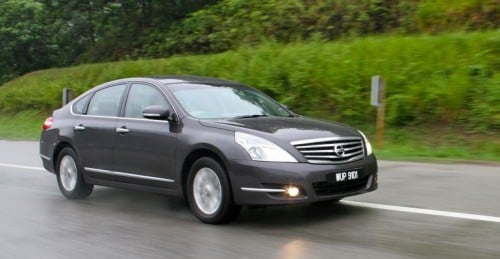
Concept cars do come to life, but sans the motorshow bling, may not be that captivating after all. I remember being at the Nissan stand at the 2007 Tokyo Motor Show, looking at the feminine product named Intima concept.
That huge sedan has morphed into the Teana that we see here, relatively intact – the shape, the signature arch, the boot shape, rear lights, and even the dash architecture, they’re all similar to what the design team envisioned. Only the concept’s impractical B-pillarless frame and four-seater layout was deleted.
In the real world, the Teana looks bigger than it really is. We’d never had guessed, but the Teana is 95 mm shorter and slimmer than the Accord. Not only big, but grand as well, which is important in a segment that satisfies the ‘luxury’ needs of the mass market.
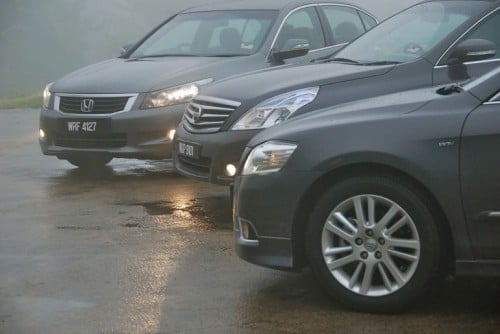
Style is subjective, but I’m not a fan of the Teana’s looks. The plain front end would be how a larger Sentra will look like if there was such a thing, but the bigger issue is the bulbous rear end of the Nissan. Backpacks aren’t the most elegant of things to carry around.
The other two are familiar views. The Accord is the largest of our trio, but its mass is masked well, while the Camry’s shape is quite timeless. Never fashionable or shouty, the Toyota was elegant when it was launched, and still looks classy today. The mid life facelift in 2009 gave it a sportier face that works well on that comparatively slimline body. Five years down the road, it’ll look the least dated.
Paul says:
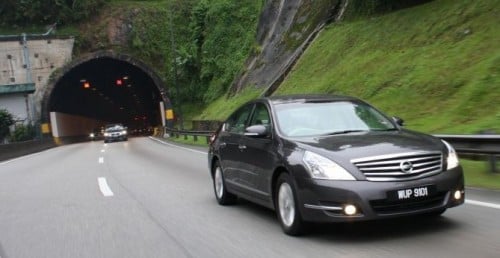
The Nissan Teana is not the most photogenic car out of the three Japanese barges in this three-way test, but I personally like its clean cut no-frills looks very much, with a big prominent chrome grille up front and sizeable headlamps. The side angle is also very clean, and this is perhaps the Teana’s best angle when you photograph it as it just presents itself as a large and grand-looking sedan, almost American in its looks.
The rear end also looks the most outstanding when parked next to the Accord and Camry – the LED design in the rear tail lamps give it a lot of character, and the Teana can also be very easily mistaken for something pricier than it really is, especially at night.
The xenon HID headlamps are very bright, and when photographing the cars we found that most of the time the camera lens was pretty much overwhelmed by the amount of light hitting it directly. I think Nissan may have angled the Teana’s HID headlamps a little too high for the comfort of other motorists (it’s JPJ approved though), although as a result it casts light further, benefiting the driver.
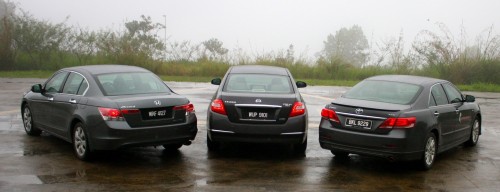
The Teana looks huge and I believe it was a conscious decision by the designers to style the car in such a way that it looks as big and grand as possible. But when parked next to the Accord and Camry, it looked curiously narrow in comparison, and you can actually see the top half of the car get slimmer by curving in from the shoulder line to the roof. The Teana didn’t just look narrow as we found out later when observing the interior.
Joining us from the H-camp is the pre-facelift 8th generation Honda Accord, which will be facelifted sometime this month. It’s got the most aggressive looking design out of the three, which kind of hides how large it looks. When you place it next to the Camry and Teana, it looks the widest as well as the longest. The rear end has the least night-time presence when compared to the Camry and the Teana, which both feature a LED design in their tail lamps.
The facelift is expected to be a very minor one – a new front grille at the front, and some minor changes to the tail lamps, as seen from the US, Thai and Japanese market facelift photos. I wish Honda could have at least added some light bars to the tail lamps to bring the design up to date. The Accord has the most adventurous design, but it seems to be getting a little old.
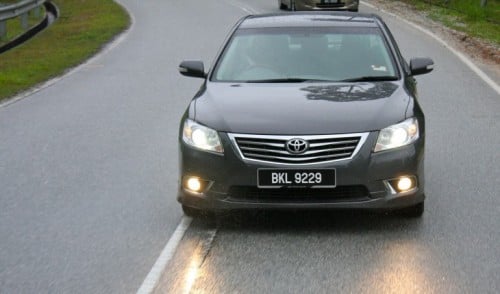
Although there exists a current generation Camry with more radical looks akin to a larger Corolla, our market’s Camry’s exterior design is very safe. What you call a Camry in the US and Japan looks very different. Our Camry is actually derived from the Australian market Toyota Aurion, and you can actually see a very nice example in Naza World with a sporty black interior and a huge and powerful 3.5 litre V6 engine.
While not particularly exciting, I reckon the Camry’s design will be the one that will age the best amongst the three here. It’s also the only one with projector headlamps.
Anthony says:

Looks are always a subjective thing, and so it is here. Now, plying the executive sedan path generally means that a design has to look more stoic than daring, if not to offend sensibilities of its intended audience, though emerging shapes in the class are displaying more fluid, flowing lines.
For me, of the trio, preference goes towards the Camry – not the most exciting, of course, but the XV40 looks like its hewn from a solid mass of metal; the lines and flow-through textures work very well, and arguably this is a shape that will retain its appeal best as time goes by. Toyota has its work absolutely cut out in making the next one as proportionately balanced, methinks.
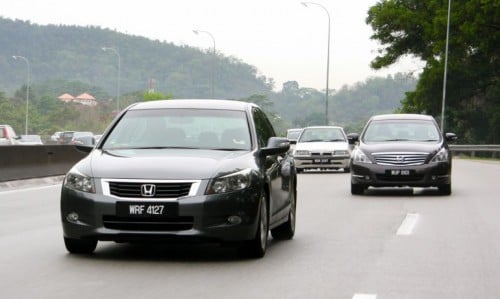
The eight-generation Accord, well, never quite worked for me. It is muscular, certainly the boldest form of the three, but somehow seems like it tries too hard in how it interprets rugged and attempts appeal. And though only three years in, it doesn’t seem to be aging well, at least to my eyes.
As for the Teana, it tries to be safe, a little too safe, in my opinion. It’s the sort of outline you give a cursory look at, but don’t really linger to dissect the lines on. The front plays the safe game to a T, but the rear jumps out at you figuratively and litreally, and looks a little too amplified in terms of proportion especially from a rear three-quarter view. Nonetheless, blend-into-the-background looks aren’t always a bad thing; you don’t excite, but you don’t offend either. Well, maybe you can hide that butt a bit better, Ingrid.
INTERIOR
Danny says:
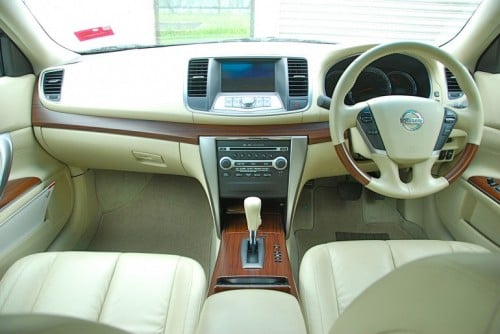
The first thing I noticed upon stepping in the Teana was the uncluttered/minimalist layout of the dash. It has the same (or more) functions than the other two, but they’re clustered in a way that makes the dash look sparse. Some will prefer this, others the button fest of the Accord, while most won’t find fault with the conventional Camry interior.
Coming from the Accord, the Teana feels narrow. The letterbox front door pockets are near useless and the centre console is slim. With the cupholders occupied, there isn’t enough space to empty my pocket’s contents. Like the Latio and Sylphy, today’s Nissan sedans aren’t the widest in their class, but they never scrimp on seat size. Speaking of that, the Teana’s seats (powered, with memory on driver’s side) are cushy and comfy. Next to Volvo, I can’t think of any carmaker that does it this way.
The luck of the draw meant that I spent most of the weekend in the Honda. It’s a dark place to be in, and I don’t particularly like the cluttered look, but it’s a conducive environment for faster/harder driving. The seats are firmest here, the lumbar support greatest, and the steering is smaller and quicker too. It’s also the only car here to have paddle shifters.
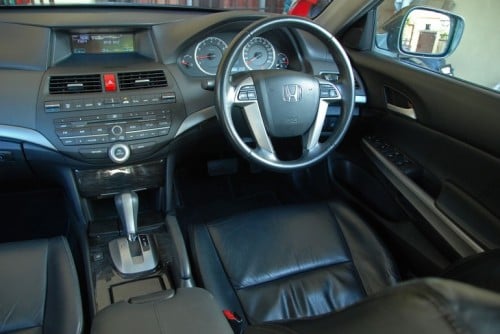
But the Accord is poor in equipment. Shockingly, this RM168k car doesn’t have a multi-info display, so there’s no way of knowing fuel consumption or available range. Personally, this is the biggest issue for me, kit wise. The others also have keyless entry with push button start while the Accord uses the standard key twist.
At the back, the big Honda offers the most legroom and feels the widest. But it’s the Teana’s light colours and well shaped bench that’s the most pleasing to the passenger. The Camry feels the coziest in the back, but it’s not what we would call cramped. The Teana is the winner in this aspect and we’re pretty sure your family will agree at the showroom.
Paul says:
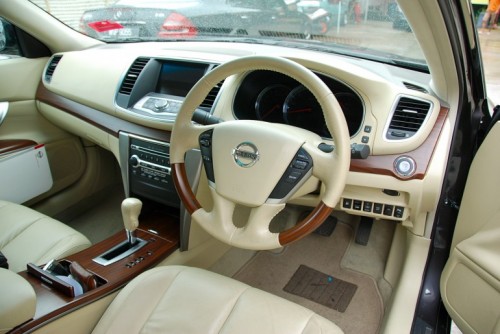
The Nissan Teana easily has the best seats of the lot. We had all three cars lined up together and tested each of the seats one by one and I felt there was a marked difference on how the Teana’s seats felt, especially when it came to the rear seats.
However, the Teana’s front seats did not have much side support, as I found out later when it was time to trash the cars around a little around the bends. The Accord had decent side support and even though Camry isn’t much of a driver’s car, there was still something at the sides to lean against.
The Accord is one huge sedan on the inside. You can really take note of this while sitting in the rear seats looking towards the front, and legroom was in abundance, easily the best amongst the three cars. The Accord was also the widest, so you may want to take note of this if you plan to frequently fit three people in the rear.
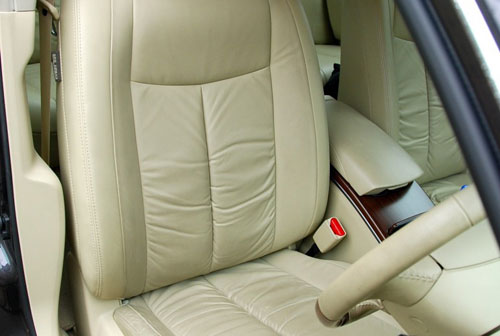
I’m very particular about car interiors – I believe it’s far more important than the exteriors in the long run as that’s where you’ll be experiencing the car the most as the owner. So I’m going to point out some issues I found. We start with the Teana. Firstly, the interior is the narrowest of the lot. As a result, the two front passengers may sometimes find their elbows touching if you’re both large.
The door cards also seem to be quite thick, but this is presumably to create a more substantial space for door-mounted arm rests, which were quite good. The door card pocket storage is pretty much useless; it’s too small to store anything other than a couple of flyers or a folder of A4 papers and it can be a tight squeeze getting your fingers in there to maneuver it around to get anything. The only storage you have is the two cupholders aft of the gear lever. I couldn’t really find anywhere to keep my Smart Tag. There’s a small area in front of the gear lever but it isn’t really a container – there’s no side support there so things tend to fly off during corners.

The thickness of the door card also made it quite a tight fit to reach the electric seat adjuster controls – thankfully the memory function buttons are mounted higher up on the doorcard near the power window controls. The position of the engine start-stop button is also perfect, and it glows with a nice amber in the dark.
While the Teana felt narrow, interior length was quite excellent, closer to that of the Accord’s rather than the shorter Camry’s. Rear passengers get ample legroom and there’s substantial space to tuck your feet under the front seats. I had an issue with the rear center arm rest though – I felt that it was very low – too low to be of any use as an arm rest for me. This isn’t even a problem with personal preference – you can actually see that the rear door arm rests are much higher than the center seat armrest.
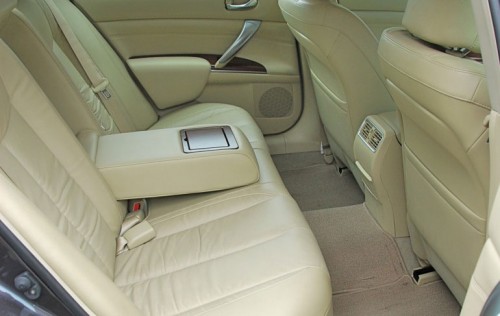
As you can see from the image above, the arm rest is of average thickness, yet it lies flat on the rear seats. Here lies the problem – the arm rest mounting point should have been mounted higher. The arm rest would end up shorter in terms of horizontal length when folded down, but this would allow a higher overall arm rest height, at least matching the arm rest height of the comfy one on the door.
The interior color theme of the Teana is rather unique. Nissan obviously picked this to give the cabin a nice airy and bright feel. I personally think it works and I have no complaints about the overall color scheme. I think it’s refreshing compared to the usual grey. But I do feel they should have made it a little more two tone – there’s actually a very nice darker shade used for the top of the dashboard but this isn’t used anywhere else in the cabin. Perhaps the top part of the doorcards and even the steering could be changed to be finished in this darker shade. Or Tan Chong could have just gone for this colour scheme (see linked image), but retain our shade of wood.
The bright beige on the steering wheel looks a little too monotonous and bottom heavy in terms of design. The all-beige steering color choice has already started to show its faults – in a Teana with close to 5,000km of mileage on it, the steering wheel is already starting to look very dirty.
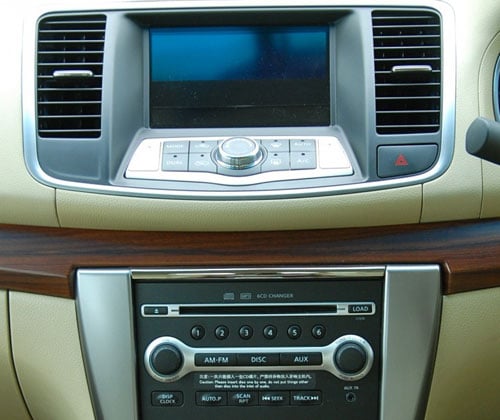
Nissan has chosen to sort of compress the areas of the interior with controls down to as little areas as possible, so what you get is lots of beige and wood with concentrated clusters of small buttons. Wherever there isn’t beige, matte faux wood usage on the surfaces is maximised so much to the point that there are only minimal cut outs in the ‘wood’-finisher for the shifter and shift position indicators.
The climate control buttons are mounted high near the multi-function display with small buttons that need some getting used to. Because of the angle that they are mounted at, I felt that you couldn’t really see what button did what easily at a glance as they’re not at a very good eye level, but I think this shouldn’t pose much of a problem over a few weeks of ownership.
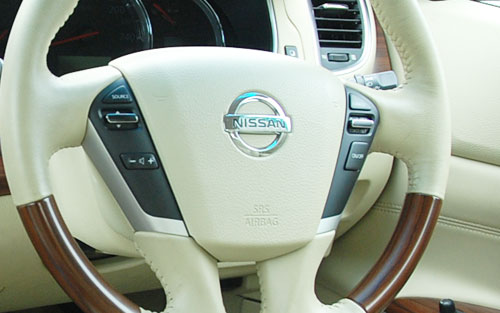
Another ergonomic issue that I had is the position of the volume control on the steering wheel – the button is quite small and is mounted quite far away from where your thumb would typically be able to reach if you’re grasping the steering wheel in a 3 and 9 o’clock position.
Arm rest issue aside, the Teana’s rear cabin space is simply the best place to be amongst all the three cars. It’s not the biggest but it’s definitely the cosiest. Thumbs up to Nissan for that.
The Accord goes with a completely different colour scheme – it’s all sporty black and grey, with a dark wood design! This kinda goes well with the car’s character actually, though you only get this in the 2.0 VTi-L and 2.4 VTi-L. The basic car gets a beige interior.
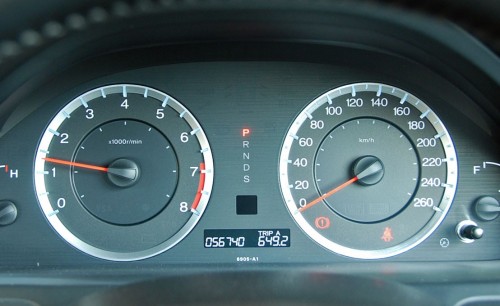
Cubby holes in the Accord was better than the Teana’s. The door pocket storage was quite usable and there was some extra storage space in front of the gear lever. Some space is sacrificed for a proper handbrake (the Teana and Camry use foot brakes) yet they’ve managed to better the Teana in this aspect.
We had some concerns on how well the Accord’s interior stood the test of time. Our test car was about three years old and you could already see the silver paint peeling off on the piece of plastic near the door armrest. There’s also no multi-info display with average/real time fuel consumption, distance to empty, etc. No keyless entry and push start button either.
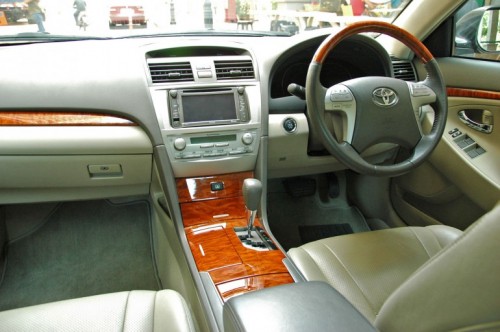
Our Camry test car was the most well appointed, with a 6-inch colour LCD 2-DIN player with Garmin GPS and reverse camera, but even that is an optional feature priced at about RM4,500. The GPS doesn’t allow you to key in addresses while you’re driving, by the way. The standard integrated head unit only has AUX input. A unique feature is the Plasmacluster air conditioner which is supposed to clean up your air. I didn’t feel much of a difference, but Anthony said it helped with the lingering smell of cigarette smoke on his clothes.
The Teana has AUX-in at least, but other than that it’s the usual case of large LCD screens in the interior that look like they could have a nice big colour screen installed, but instead are only filled with monochrome screens displaying large calculator-like fonts.
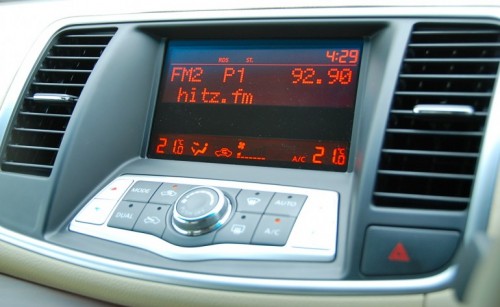
We don’t understand why these expensive D-segment cars sometimes offer so little in terms of standard multimedia features when even a car like the Perodua Myvi has Bluetooth and USB input. Even the Proton Exora has Bluetooth capabilities with steering wheel controls for telephony functions.
In terms of overall design and ergonomics, it’s hard to find fault with the Camry, other than the shiny brown wood, which looks a little tacky. Buttons and knobs are all very intuitive to find and use, and the Camry’s interior is by far the most convenient. The area between the two front seats has been maximised with two storage areas, and there are even two power sockets at the front – one at the usual cigarette lighter location below the radio, and another in one of the storage areas in between the front seats. The door pockets are more usable than the Teana’s too.
I like the additional passenger seat angle and slider controls that are easily accessible for the driver. There’s also a unique feature where you can even control the Plasmacluster air conditioner from the steering wheel, so the reason for you to take your hands off your steering wheel while driving are minimal. Everything is just very well sorted out.
Anthony says:
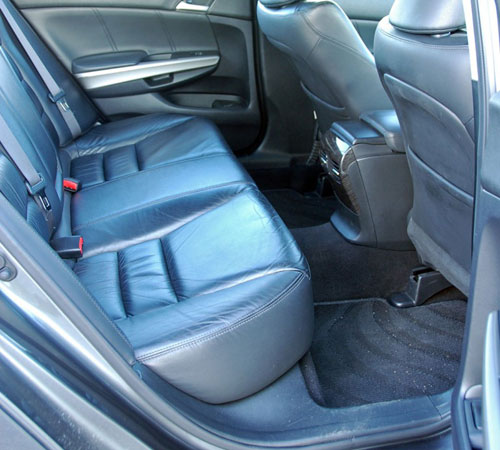
Space should be a bit of a given for cars of this nature, and happily all three have ample enough to offer inside. At the back, the Accord, which has the largest cabin (and indeed, the largest car of the lot), takes the gong.
Even with a black interior, its volumetric scope is undeniable. Get into the back and you get a cavernous fore-aft perspective, and the front has oodles of space too. Its dashboard layout is certainly the most aggressive of the three – you either love the futuristic rocket-ship presentation, or you don’t.
Meanwhile, the Camry also has good dimensional acreage, second in terms of space offered at the back. Of course, while the Teana may be the smallest of the lot, it doesn’t feel cramped, and it actually has the best rear seats – they’re cosier than the Camry’s and the Accord’s.
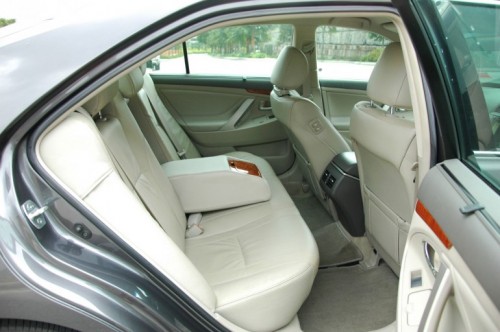
Storage-wise, from a driver’s point of view, the Camry has got the best spread of the trio – never face a quandary where to plonk your keys, phone and other what-not items with this one. The Accord rolls in a neat second, even with a levered handbrake taking up space. As for the Teana, it could have offered more in the way of cubby-holes (and that door side pocket won’t hold anything significant).
As for dashboard presentation, the Camry again has the broadest appeal of the three; it doesn’t look expensive, but has a refined, plush feel about it that the other two don’t have about them. It’s also the easiest to work around, visually.
The Teana’s dash layout – which follows on that in the Murano – takes some getting used to; nothing wrong with the central console screen’s legibility and visual acuity ease, height-wise, but the rest of the instrumentation is a bit trickier. Angled as they are, the climate control buttons are a bit difficult to view at eye level (well, maybe not if you’re 6ft 4); likewise, the audio buttons. Still, if you own one, this point shouldn’t be a contention after a while.
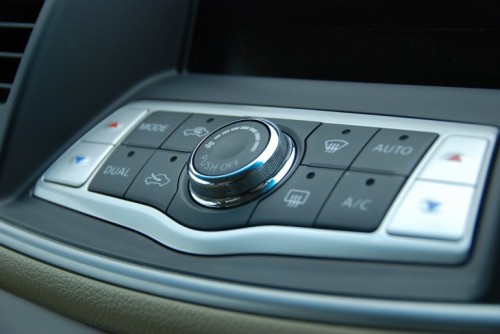
Meanwhile, the creamy beige shade chosen undoubtedly brightens the Teana’s cabin, and thus lends it more sense of spaciousness, but some elements look like they won’t face hard usage well. Take the steering wheel, for example. The leather wrap on it was already getting a bit skanky, and this on a car with only 6k on the odometer, so you can imagine it after 60k.
So, the honour of having the best cabin goes to the Camry. Indeed, we had trouble picking up faults or items lacking in the Toyota. It really is that well-thought out, save perhaps in one little area. Access to the push-start button, which is hidden away on the left behind the steering wheel, could be better. The Teana’s, sitting right on the edge of the dashboard, is perfectly placed (and it’s a way cooler-looking item). Speaking of push-start and keyless go, the Accord’s ignition key is now looking decidedly tired, and chances are the soon-to-arrive mid-term facelift won’t have it too.
PERFORMANCE
Danny says:
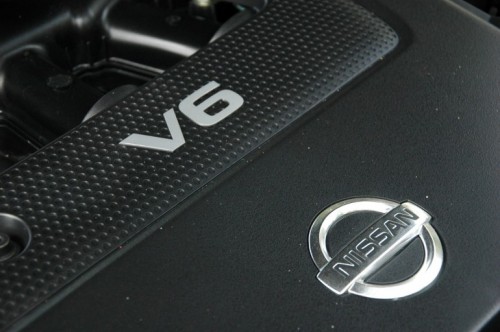
Everyone in this office loves the Teana’s creamy V6 sound and grunt, me included, but I have a thing for the Accord’s K-series engine. Rev loving like only a Honda four-cylinder (or an Alfa Twin Spark) can, the Accord’s 180 PS motor grabs an energy bar when it passes 4,000 rpm and powers on to the red line with gusto. The raw mechanical scream is also unique. While you’re enjoying this, many other four pots are either fading away or begging for mechanical sympathy by vibrating.
It’s easy to deceive these days when it comes to gearboxes, just put in a minimum of six forward ratios (more is better) even if the car doesn’t need it and your product will be hailed as technologically superior. Not sure about you, but if forced to choose one, I’d rather have quality over quantity. The Accord’s five-speed auto is a good example of ‘just right’. It’s so slick that there wasn’t a situation where it was caught off guard, thinking twice or hesitating. So good was the telepathy, the shift paddles were left alone for the most part.
I covered over 400 km of midnight country road driving in the Honda, and it left me with no doubt that it’s the best driver’s car of this group. The biggest car here feels like the smallest to drive. Quick and light steering with decent feel, good body control, grippy chassis and the abovementioned drivetrain combine for an engaging drive. The ride is never too firm or harsh on this 17-inch wheeled 2.4 either, so it’s the best package in my view.
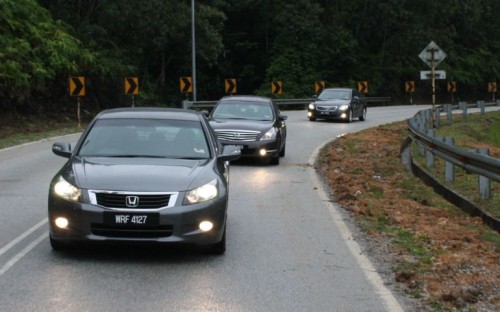
If there’s a complaint, it’s the higher than normal road roar and tyre noise from the Honda, exposed by the comfort-oriented Teana and Camry. The Nissan isn’t just very plush riding, it handled surprisingly well. To be honest, I approached the Teana expecting a super soft, wallowy boat, but it proved me wrong. Yes, the steering wheel needed bigger turns and the tyres don’t major on grip, but the Teana’s composure when driving hard is impressive. The CVT isn’t the best tool for our blast up the hills, but the Nissan was quick, as our diesel-powered Mercedes-Benz photography car can testify.
The Teana is very pleasant in city driving. Nissan’s Xtronic CVT is very responsive and is a far cry from the early CVTs introduced to Malaysians. Common booby traps such as pot holes, scarred surfaces and highway expansion joints are damped nicely, a skill that’s not as common in this class as you think.
The Camry’s roadholding was the opposite of impressive. It rained the whole weekend, and the Toyota was all over the place the few sectors I drove it. Fast sweepers on the Karak highway revealed the Camry’s low limits. It wasn’t helped by the glassy feel of the steering, which gives you very little idea of how much the tyres have in reserve. It ends up as the least confidence-inspiring car to drive here.
Paul says:
The Nissan Teana is the clear winner here, which is no surprise given that the V6 engine has the largest cubic capacity of all the three cars. It makes 182 PS at 6,000 rpm and 228 Nm of torque at 4,400 rpm, which on paper doesn’t stray far from the Accord’s 180 PS at 6,500 rpm and 222 Nm of torque at 4,300 rpm, or the Camry’s 167 PS and 224 Nm at 4,000 rpm.
CVT transmission puts the V6 in just the right powerband all the time and the Teana pulls away significantly strongly than the Accord or the Camry, while keeping its revs around the 3,000 to 4,000 rpm range. The V6 sounds silky smooth and most people would probably never want to go back to a four-cylinder after driving a car with one. A four-pot somehow feels a little downmarket when you compare it a V6.
Toyota’s 2.4 litre engine doesn’t make much power, but the driveability is quite good for the kind of driving it does as there’s a good amount of torque in the mid-range. It kinda runs out of steam in the higher RPMs although it remains refined. The Accord’s 2.4 litre engine makes a lot of power on paper but curiously it’s a little lazy in the low revs – you really need to pile on the revs for it to pull strongly. The engine in the Accord also sounds louder.
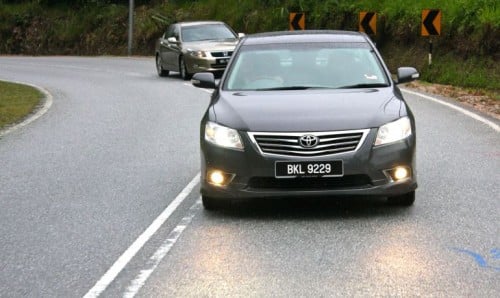
The Toyota Camry’s suspension is completely comfort biased. You can actually just run over bumps like you were driving an SUV and the Camry seems to smoothen out all the bumps and knocks that our Malaysian roads can give it. It also felt the most quiet, although the Teana was very close behind. The Accord on the other hand, had a noticably higher sound level. However, the Accord performed the best during a hill run between the three cars, with the Camry driver having to push the car to about 90% of its capabilities just to keep up.
To be honest, the Camry is completely unsuited to any kind of spirited driving. It’s suspension is very comfort biased and at times a little unsettlingly so, as you can feel the effects of crosswinds much more in a Camry than the Teana or the Accord. But I prefer the Camry’s steering weight to the Accord’s – the Accord had the lightest steering although it had plenty of feel in it, while the Camry’s steering is pretty isolated. Light steerings make a car feel a little nervous and you have to take care to make sure you hold the steering properly at higher speeds, as it just feels too loose.
The Teana’s steering was kind of like the Goldilocks porridge of D-segment steering – it’s got just the right kind of weighting and some good feel as well. The ratio could have been a little quicker though – it felt like you had to turn the steering a little more than usual to change direction. The Teana rolls in for a corner at a nice pitch, and although it doesn’t corner flatly it remains quite steady through the turn, while the Camry is quite floaty. The Teana is a little firmer, although still comfortable. The Accord of course leaves the two cars in the dust when it came to the hill run.
Anthony says:
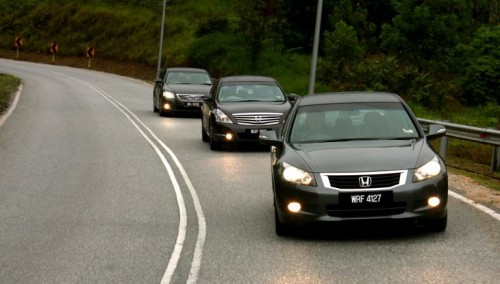
Here’s where things get noticeably broader in scope. The trio exhibit very different characteristics, with the Accord continuing to be the most dynamic of the trio. True, that 2.4 litre lump isn’t the quickest off the line, and only offers its magic when you work it hard, but keep it humming within the power band and it’s a right stonker. It is also the loudest of the three pots when you belt it.
At low to mid-speed levels, and tackling terrain such as Bukit Tinggi, one of the areas we took the cars to, the Honda champs it, with the fast steering and equally adept response from the chassis right at home in these conditions.
The Camry, of course, is pretty much out of its element in the twisties. Going uphill – in wet conditions, mind you – and chasing after Danny in the Teana (which looked fairly comfortable hustling its way up) made for some rather, shall we say, breathtaking moments; I don’t think I’ve ever heard the VSC in a Toyota go off repeatedly as much as then. It’s not something I’m inclined to repeat. Sitting at the very limits is fun, but definitely not in a car like this.
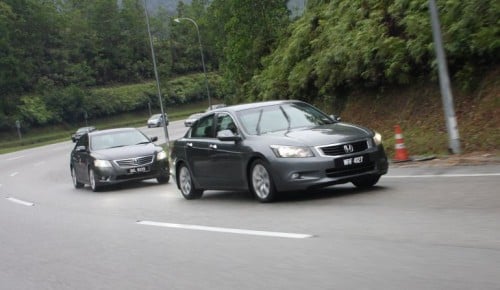
But that’s not what the Camry is about. Actually, that’s not really what any of these three cars are about, but it’s nice to know that something like the Accord is there for the enthusiast who wants to let his hair down once in a while, even if he has had to acquire some responsibility – and an executive sedan – along the way. It’ll certainly be intriguing to see how it shapes up against the likes of the Kia Optima, if that one does arrive here with the equivalent of the Oz suspension tune.
Out in the highways and piling on the miles in a straight line, the Camry more than restores its pride. It does remarkably well, actually. The 2AZ-FE has more poke than the Honda pot at low to mid levels, so there’s better immediacy and take-up. The steering does the deaf and mute act in accomplished fashion, and it’s also the quietest of the three cars in terms of road and tyre noise. Simply put, that decoupled steering and soft suspension do a remarkable job of making everything downright compliant and as cushy comfy as can be.
The Accord, ever the boisterous gal, doesn’t just have a raucous, zingy sounding block, it’s loud in other areas as well; compared to the Camry and Teana, it has certainly got far higher levels of tyre and road noise. So, there’s a price to be paid for all that handling and performance. Well, if you end up with a vixen, be prepared for her to also be a screamer when the going gets heavy.
The Teana proved the surprise pick; that 2.5 litre V6 deserves all the plaudits it has earned, and the CVT is smoothly efficient right up the range. I’d expected it to present things closer to the Camry, with soft and wallowy being choice adjectives, but this was far from being the case. Its suspension at low-speed levels is actually the firmest of the lot, but it’s never jarring, and while it doesn’t remain as taut as the Accord does when pushed (or arguably, hold the lines as well), the car keeps its composure very well. There’s a fair amount of pitch, but it is by far more poised than the Camry doing bends in rapid fashion.
CONCLUSION
Danny says:
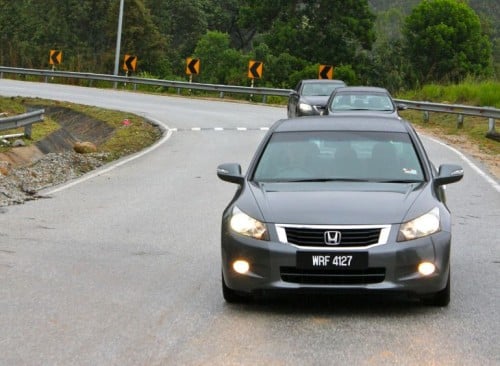
Generally, a D-segment ‘big car’ is bought mostly for image, luxury and comfort, and what I like about the Accord is most probably of no concern to the average punter. Should I be in the market for one of these, it’ll be the Accord for its ability to entertain. Honda is very stingy though; the Accord’s kit list is way below par. We’ll see if the impending minor facelift addresses this.
The best all rounder here is the Nissan Teana. The newcomer is comfortable, as well kitted as the Camry (the Teana is cheaper by RM2k) and better to drive than the market leading Toyota. You’ll also enjoy the luxury of a pedigree V6, the only such engine in a class of four cylinders. Shoppers in this segment have to at least give the Nissan a test drive.
Paul says:

To be honest, I had a very hard time picking between the Teana and Camry for this D-segment Japanese car shootout. The Accord just wasn’t a car that had the characteristics I was looking for. I set myself out to be a buyer looking for a nice comfortable A to B runner, someone who already had a fast car for his weekend monkey-business. It was a very close fight – the Teana had lovely seats and the best powertrain combo but the Camry had a very much better thought out and convenient interior.
I only made a firm decision on Sunday night, when I was driving the Camry back from KLIA on the MEX highway. For those of you in the Klang Valley, you’d remember a seriously heavy rain storm in the early night. It was pouring heavily and there was a lot of wind. It wasn’t very pleasant driving in the storm in a car with not much steering feel and a body that was rocking with the heavy winds.
To be honest, I have no idea how the Teana would have tackled that situation, but it made me think of passive safety and things like steering safely around obstacles on the highway. I reckon the Teana could probably do a brake and swerve maneouvre better than the Camry. So, I’d have to go with the Teana.
Anthony says:

Spiritually, the Accord is my kinda broad. It’s a real vamp when you consider that the other two list librarian and accountant under vocation (alright, so I’m taking liberties with creative licence here), and its Goth-like nature appeals to the driver in me.
Still, at the risk of slapping myself, I actually ended up liking the Camry more. I can imagine the other half keeling over in response to this if I told her that. “What? Camry? YOU??” would be pretty much it. But when you’re not wanting to get around in a hurry, like over the weekend, the Toyota was actually a (*grits teeth*) great place to be in. I can now begin to see why the XV40 appeals as it does to many.
In all, I thought the Teana was actually the most balanced of the three in terms of overall performance over the various driving conditions. There’s plenty of pep, and it seems adept in all areas. In effect, it sits right in the middle performance-wise, not too soft or lazy, and not too hard or unforgiving. As much as I love the Accord’s precise handling and positioning sense, and the Camry’s magic carpet treatment and unfettered presentation, the Teana’s middle ground treatment strikes the best balance. Not too dull, not too fiery, in essence, just right. Now, if only it managed to get some right clothes and slap some make-up on, you can imagine it’d be the sort of car Goldilocks would be most happy in.
FUEL CONSUMPTION
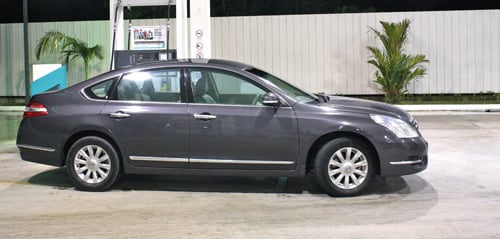
As we expected, the larger V6 engine ended up being the thirstiest of the three. The test was conducted across mixed driving conditions with the three cars traveling together in a group, including our Mercedes-Benz CDI photography car. The route was to fuel up and meet at the start of the KL-Karak Expressway (from different directions), drive up the winding stretch (moderate speeds), exit at Bukit Tinggi, climb (flat out) and descend the hill (cruise down), and cruise again back to KL, with the finish point at MRR2. All three cars were switched between three drivers.
Not exact science, but here are the results:
- Camry: 77.1 km, 9.41 litre = 8.2 km per litre
- Accord: 83.1 km, 9.37 litre = 8.9 km per litre
- Teana: 86.4 km, 11.46 litre = 7.5 km per litre
We expect the gap between the two 4-cylinder cars and the V6 car to become smaller on a driving cycle that has less “gutsy driving” as compared to ours.
PRICE
- Honda Accord 2.4 VTi-L – RM172,800
- Nissan Teana 250 XV – RM173,000
- Toyota Camry 2.4 V – RM174,990
Photos by Anthony Lim, Charles Leong and Danny Tan.
POLL
[polldaddy poll=4720755]
GALLERY: Honda Accord versus Nissan Teana versus Toyota Camry
GALLERY: Honda Accord
GALLERY: Nissan Teana
GALLERY: Toyota Camry
Looking to sell your car? Sell it with Carro.

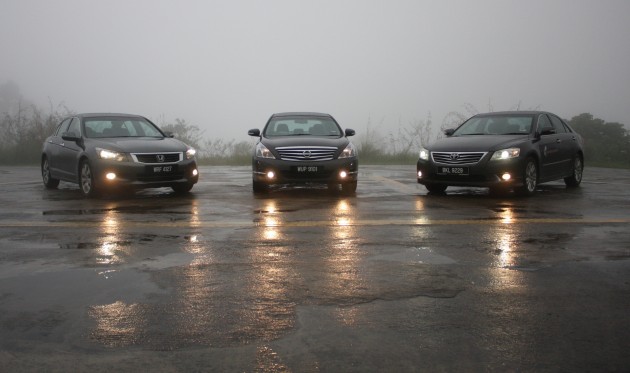
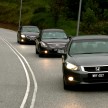

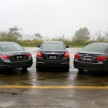
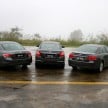

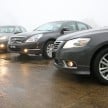
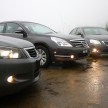
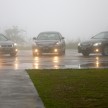
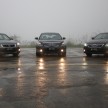
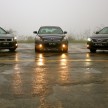

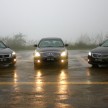
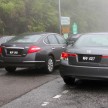
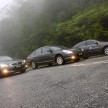
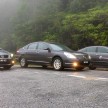
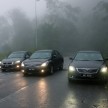
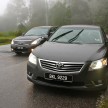

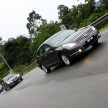

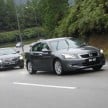
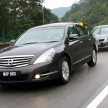


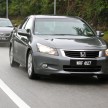

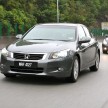
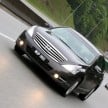

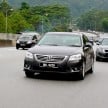





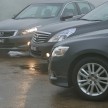
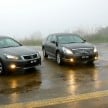
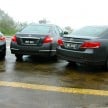


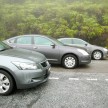
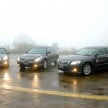
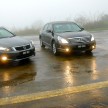
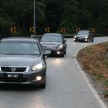
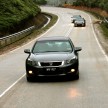
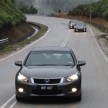

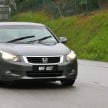
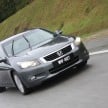
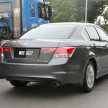
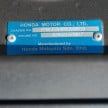

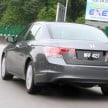
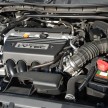
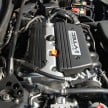
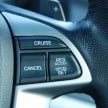
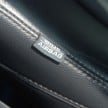
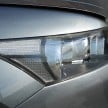
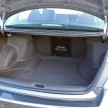
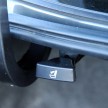
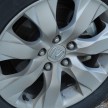
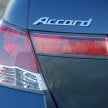
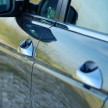
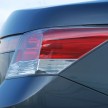
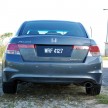
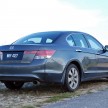

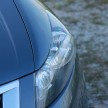
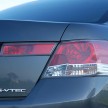
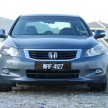
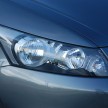

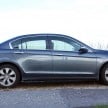
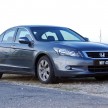
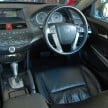
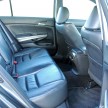
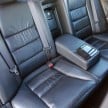
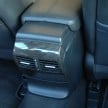
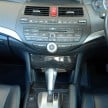
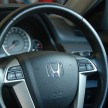
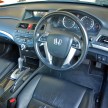
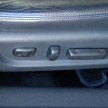
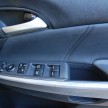
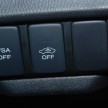
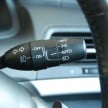
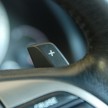
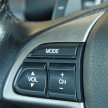

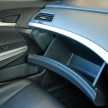
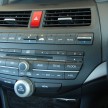
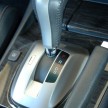
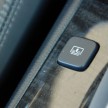


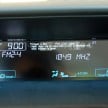
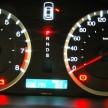
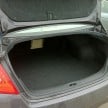
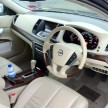
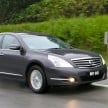

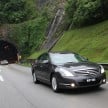
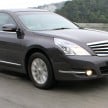

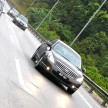
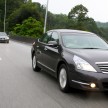
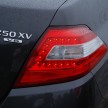
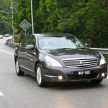
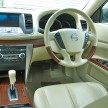
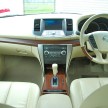
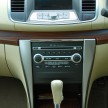
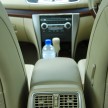

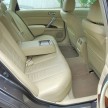
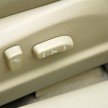
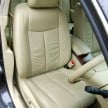
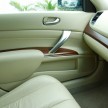
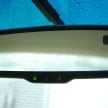
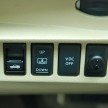
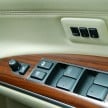
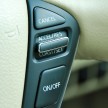
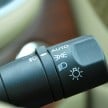
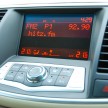


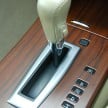
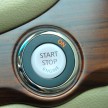
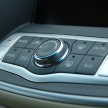
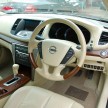
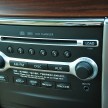
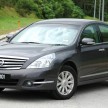
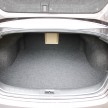
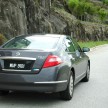
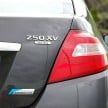
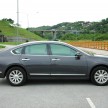
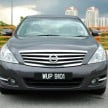
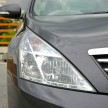
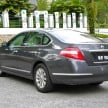
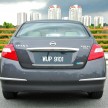
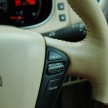
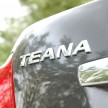
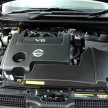
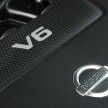
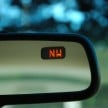
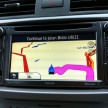
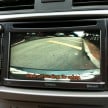
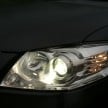

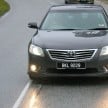
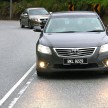
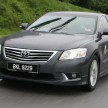
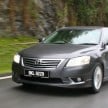
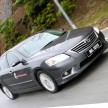
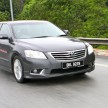
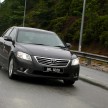
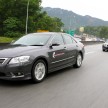
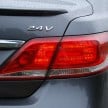
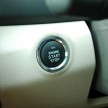
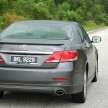
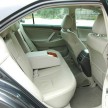
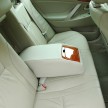
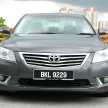
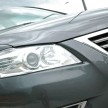
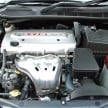
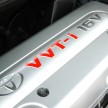
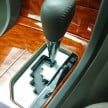
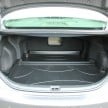
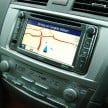

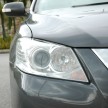
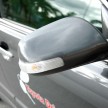
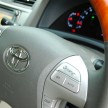
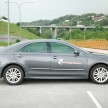
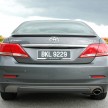
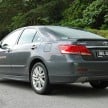
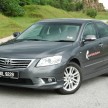
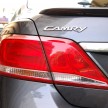
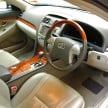

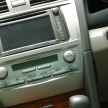
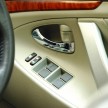
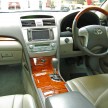

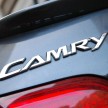
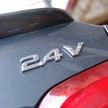



















AI-generated Summary ✨
Comments praise the detailed and comprehensive review of the Honda Accord, Nissan Teana, and Toyota Camry, with many readers expressing their appreciation for the balanced pros and cons list. Several mention their personal decisions influenced by the review, with some planning to buy the Camry or Teana. There is enthusiasm for future comparisons including other segments like Korean or European cars, as well as suggestions to include models like Mazda 6 and Kia Optima. Some comments briefly discuss car features such as interior quality, engine performance, and fuel economy, while others compare styling and design preferences. Overall, sentiments are positive toward the review’s thoroughness, with anticipation for more such comparisons and a few humorous or off-topic remarks.